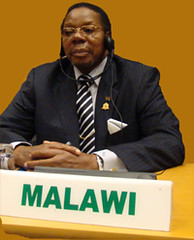
Malawian President in his capacity as Chairman of the African Union, 53-member state regional organization for the continent.
Originally uploaded by Pan-African News Wire File Photos
By Hebert Zharare recently in Nsanje-Malawi
Courtesy of the Zimbabwe Herald
On October 23 this year Malawi made history.
In one of its driest regions, about 400 kilometres south of the commercial capital Blantyre, one of the continent’s biggest inland cargo handling facility — Nsanje World Inland Port — was opened.
The total construction cost: US$3,9 billion.
Three great African leaders — President Mugabe, Rupiah Banda of Zambia and Bingu waMutharika of Malawi — graced the opening of the facility on the Shire River.
Landlocked countries such as Malawi, Zambia and Zimbabwe are likely to improve their import and export volumes following the opening of the facility on Malawi’s biggest river.
The Shire River flows into the Zambezi River and on to the Indian Ocean via Chinde Port in Mozambique.
It is 238km from the Mozambican port and over 260km from the Indian Ocean.
President Mutharika presided over the ceremony.
President Mugabe’s delivery to the delegates was characteristically robust, as he called on Africans to shape their own destiny by initiating homegrown solutions when dealing with the continent’s challenges.
Addressing the people who braced roasting temperatures that reached 50 degrees Celsius on Saturday, President Mugabe called on African leaders to shun donor-driven development, with its strings attached, in favour of homegrown initiatives.
"Other countries in the world want to think for us. They do not want us to think for ourselves.
"They critise projects like this one that are of our own thinking . . .They put NGOs here, NGOs there even though we do not need them.
"NGOs even want to teach (President Bingu) waMutharika how to run his country.
"That, we should be worry about . . .They become dangerous creatures among us and beware of them.
"Those that are good that want to work with us let them come like the Portuguese company (Motal Engil) that constructed the port," he said to thunderous applause.
Before the construction of the port, traders in Malawi had been using Beira in Mozambique, a round trip of more than 1 700km.
Mr Shadreck Matsimbe, executive director of the Malawi Road Transport Operators Association, said: "A return trip to Nsanje is only 400km, which will allow transporters to save on transportation costs."
Transport costs have driven the prices of imports and exports with insurance charging for potential accidents and thefts.
The land around the port has already been sold to various businesspersons, revealed Nsanje district commissioner, Mr Rodney Simwaka.
According to Mr Simwaka, over 800 applications for land have so far been received from locals and foreigners wishing to venture into the tourism and hospitality industries, transport and cargo, and retail among other businesses.
According to the chairman of organising committee that managed the project, Mr Sidik Mia — who is also Malawi’s Transport and Public Infrastructure Minister — Nsanje is the fastest developing region in the country.
Malawi expects to save US$175 million on its annual import bill when the new port becemes fully operational in December 2010, Minister Mia said.
"The government hopes that the reduced transport costs will facilitate increased production of crops such as maize, cassava, sweet potatoes and rice.
"This will enhance the country’s food security."
President Mutharika said Malawi was not a "landlocked" country anymore due to the port.
He said through cross border activities, the impact of the new port would be felt in Zambia, Mozambique, Tanzania, Zimbabwe, Burundi, Rwanda and the DRC.
"The Nsanje Port is not only for Malawi. It is for many countries in the Sadc region.
"It is Malawi’s desire to develop the Nsanje Port to the standards of the Hamburg Port in Germany," he said.
President Mugabe supported him: "We people from Sadc must look at this project as our project together.
"Let’s enable it to function fully. The people of Zimbabwe will support this project by having some of our import and export goods pass through this port."
President Banda called the port a "dream come true" for the region.
He said the port would also assist in lowering the cost of living in a number of Sadc countries.
However, President Mutharika was not impressed by certain developments.
The official opening was supposed to coincide with a trial run with a barge carrying over 200 tonnes of fertilizer arriving.
President Mutharika told the multitude that the Government failed to clear the barge with the Mozambique Government.
It is reported that another challenge was Mozambique was calling for an environmental and economic viability study before navigation of the Zambezi River is allowed.
Despite all this, Motal-Engil Group said it had capacity to handle over 10 000 containers yearly, amounting to over one million kg of cargo.
Motal-Engil Malawi managing director, Mr Manuel Teixeira, said the company would invest 15 million euro in the project under a Build-Operate-Transfer agreement.
Designed by ZLH Projects and Naval Architects Limited, the port will include a mobile port crane, roll-on and roll off facilities, retaining structures, navigation aids, container stacking and handling areas, general cargo handling and storage areas, weighbridge, ware houses, electrical substation, office buildings and vehicle parking facilities.
Mr Teixeira said the harbour would have a minimum lifespan of 50 years and was designed to handle different types of vessels with a carrying capacity of up to 48 containers of 20 feet length.
"One vessel alone of about 27 metres long can carry up to 2 600 containers a year and the target for the Nsanje World Inland Port is to handle 10 000 containers," he said.
He said the Nsanje Port would be able to operate 24 hours a day all year round and maintenance work, where necessary, would be carried out without interrupting port operations.
Phase two of construction work involves erection of offices for port authorities and the Malawi Revenue Authority, all covering 10 000 square metres.
No comments:
Post a Comment